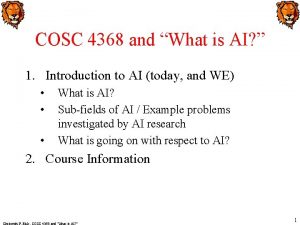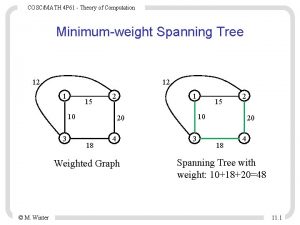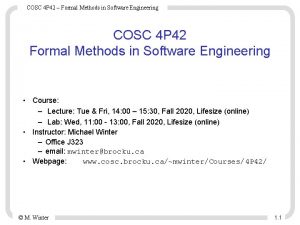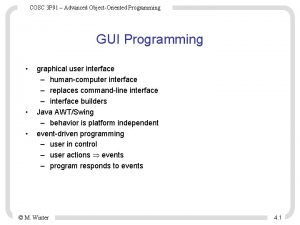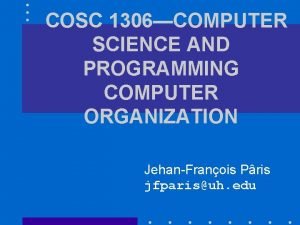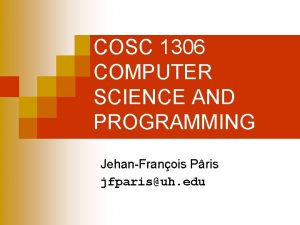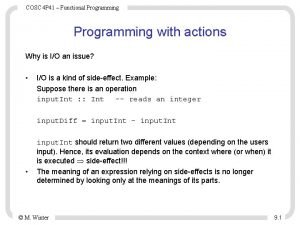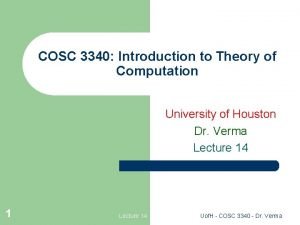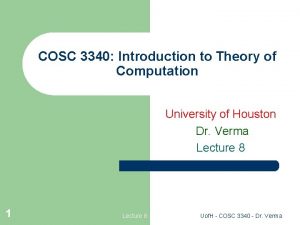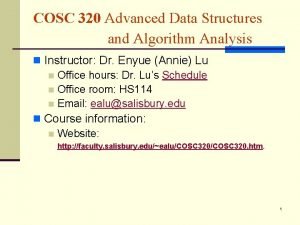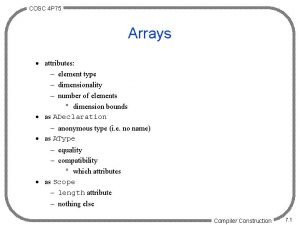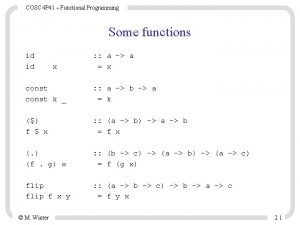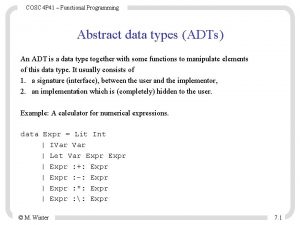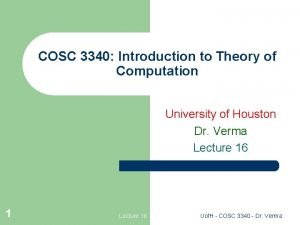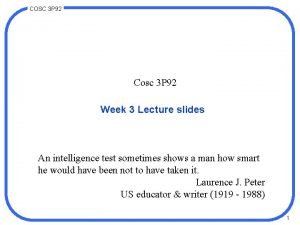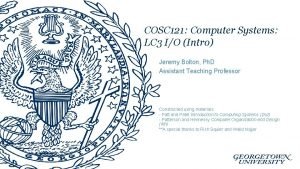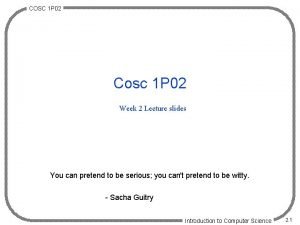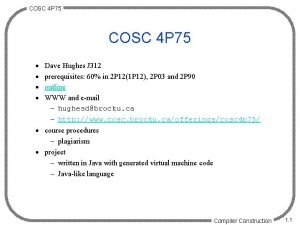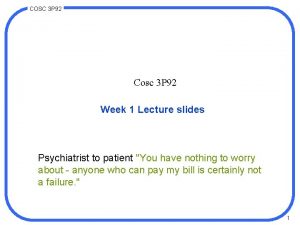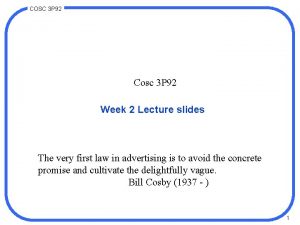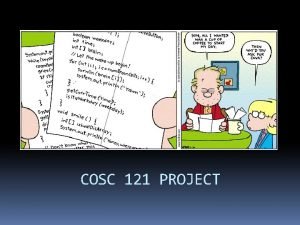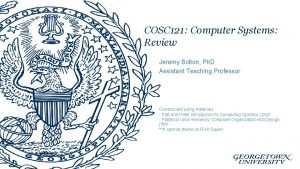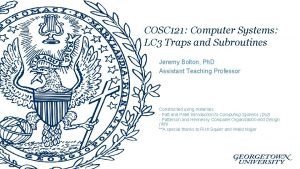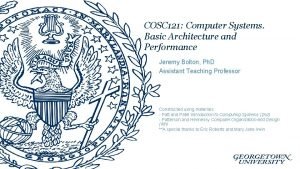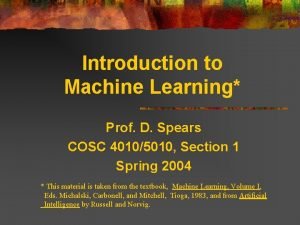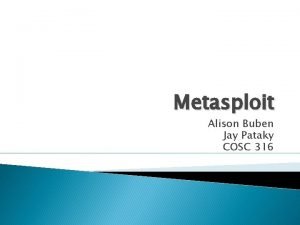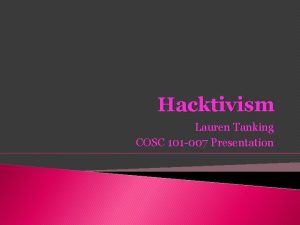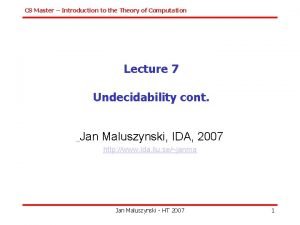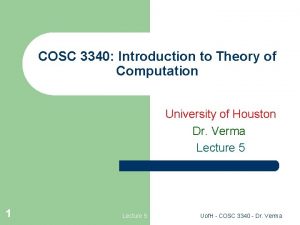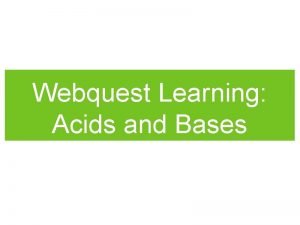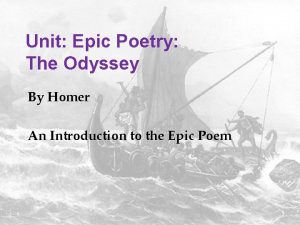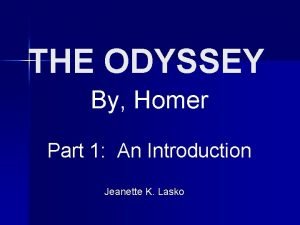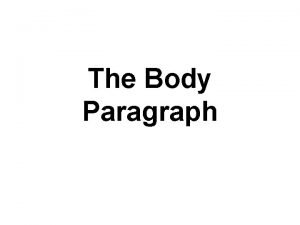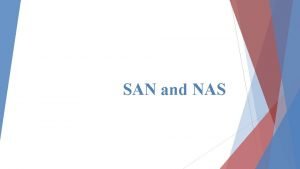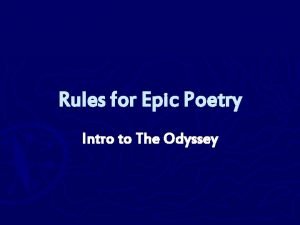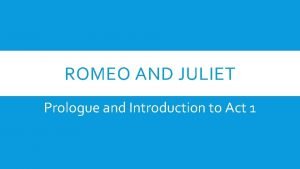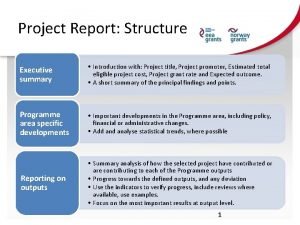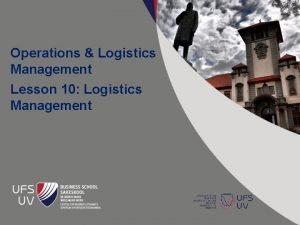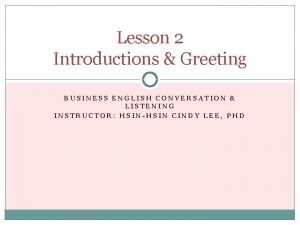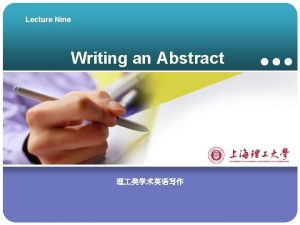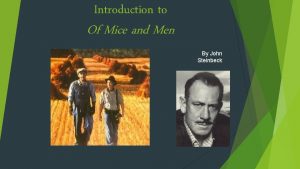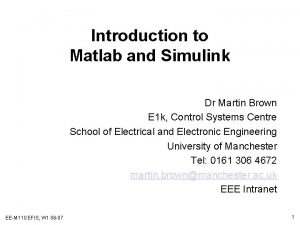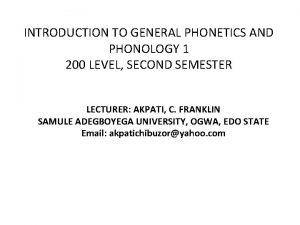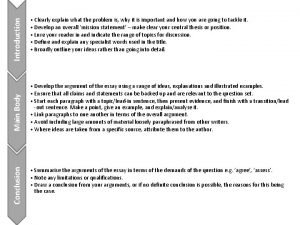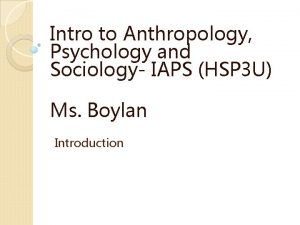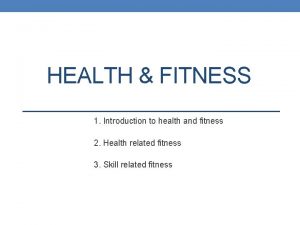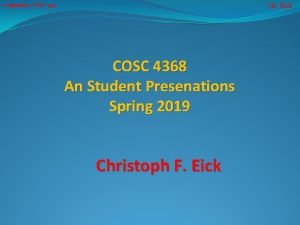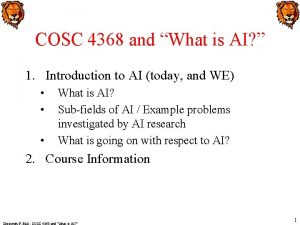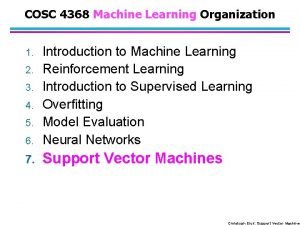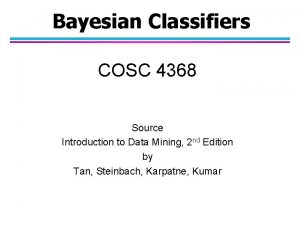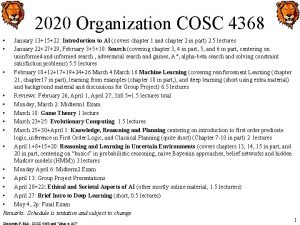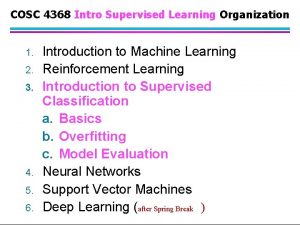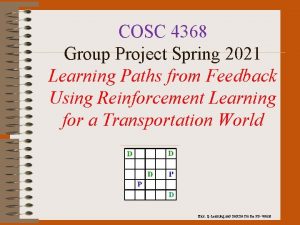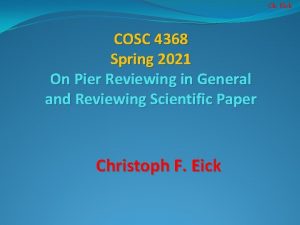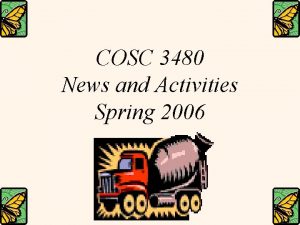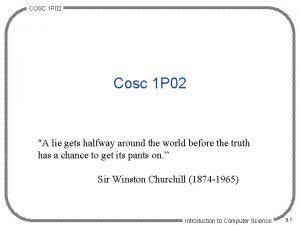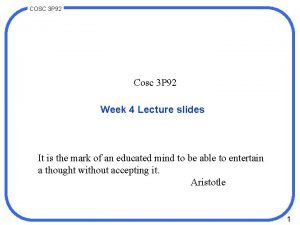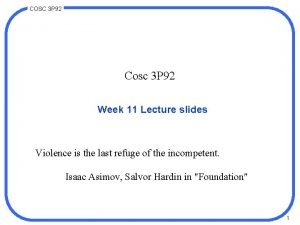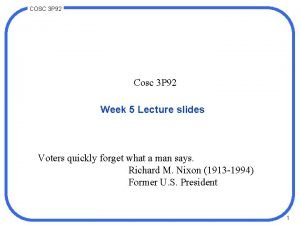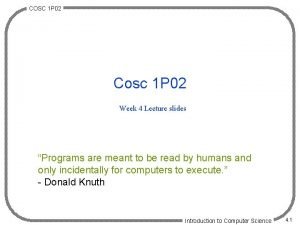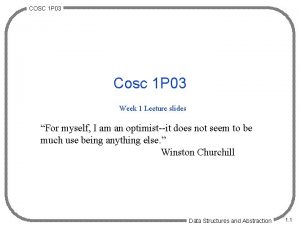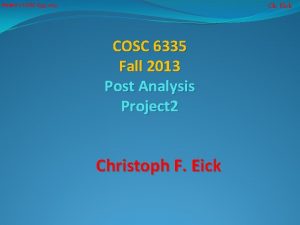COSC 4368 and What is AI 1 Introduction































![Knowledge Discovery in Data [and Data Mining] (KDD) Let us find something interesting! • Knowledge Discovery in Data [and Data Mining] (KDD) Let us find something interesting! •](https://slidetodoc.com/presentation_image/325348eca9e26d56e394094129cc43b6/image-32.jpg)












![Motivation: virtual assistant Tell information Ask questions Use natural language! [demo] Need to: • Motivation: virtual assistant Tell information Ask questions Use natural language! [demo] Need to: •](https://slidetodoc.com/presentation_image/325348eca9e26d56e394094129cc43b6/image-45.jpg)












![Pac-Man [demo] Pac-Man [demo]](https://slidetodoc.com/presentation_image/325348eca9e26d56e394094129cc43b6/image-58.jpg)







- Slides: 65

COSC 4368 and “What is AI? ” 1. Introduction to AI (today, and WE) • • • What is AI? Sub-fields of AI / Example problems investigated by AI research What is going on with respect to AI? 2. Course Information 1

Part 1 a: Definitions of AI • “AI centers on the simulation of intelligence using computers” • “AI develops programming paradigms, languages, tools, and environments for application areas for which conventional programming fails” – – – Symbolic programming (LISP) Functional programming Heuristic Programming Logical Programming (PROLOG) Rule-based Programming (Expert system shells) Soft Computing (Belief network tools, fuzzy logic tool boxes, …) – Object-oriented programming (Smalltalk) 2

More Definitions of AI • Rich/Knight: ”AI is the study of how to make computers do things which, at the moment, people do better” • Winston: “AI is the study of computations that make it possible to perceive, reason, and act. • Turing Test: If an artificial intelligent system is not distinguishable from a human being, it is definitely intelligent. • https: //en. wikipedia. org/wiki/Turing_test • Eugene Goostman Winner 2014 Touring Test: https: //en. wikipedia. org/wiki/Eugene_Goostman • Please read: http: //www. zdnet. com/article/beyond-cortana-what-artificial-intelligence-means-for-the-future-of-microsoft/ 3

Physical Symbol System Hypothesis • “What the brain does can be thought of at some level as a kind of computation” • Physical Symbol System Hypothesis (PSSH): A physical symbol system has the sufficient and necessary means for general, intelligent actions. Remarks PSSH: 1. 2. 3. Subjected to empirical validation If false AI is quite limited Important for psychology and philosophy 4

Questions/Thoughts about AI • What are the limitations of AI? Can computers only do what they are told? Can computers be creative? Can computers think? What problems cannot be solved by computers today? • Computers show promise to control the current waste of energy and other natural resources. • Computer can work in environment that are unsuitable for human beings. • If computers control everything --- who controls the computers? • If computers are intelligent what civil rights should be given to computers? • If computers can perform most of our work; what should the human beings do? • Only those things that can be represented in computers are important. • It is fun to play with computers. 5

AI https: //en. wikipedia. org/wiki/Watson_%28 computer%29 9 https: //en. wikipedia. org/wiki/Watson_%28 computer%29 CS 221 / Autumn 2018 / Liang

Companies ”An important shift from a mobile first world to first world” [CEO Sundar Pichai @ Google I/O 2017] an Created AI and Research group as 4 th engineering division, now 8 K people [2016] Created Facebook AI Research, Mark Zuckerberg optimistic and invested AI very Others: IBM, Amazon, Apple, Uber, Salesforce, Baidu, Tencent, etc. 7 CS 221 / Autumn 2018 / Liang

Governments ”AI holds the potential tobe a major driver of economic growth and social progress” [White House report, 2016] https: //www. whitehouse. gov/briefings-statements/artificial-intelligence-american-people / Released domestic strategic plan to become world leader in AI by 2030 [2017] https: //www. nytimes. com/2017/07/20/business/china-artificial-intelligence. html ”Whoever becomes the leader in this sphere [AI] will become the ruler of the world” [Putin, 2017] https: //www. theverge. com/2017/9/4/16251226/russia-ai-putin-rule-the-world https: //yourstory. com/2018/02/budget-2018 -artificial-intelligence-fuel-indian-economy/ 8

AI index: number of published AI papers

AI index: number of AI startups CS 221 / Autumn 2018 Liang

Stanford CS 221 enrollments 800 600 400 200 0 2012 2013 2014 2015 2016 2017 2018 Slowing down? Probably due to the CS 221 spring offering. . . 14 CS 221 / Autumn 2018 / Liang

Topics Covered in COSC 4368 • More general topics: – Exposure to many search algorithms – Making sense out of data (kind of Data Science) • AI-specific Topics: – Reasoning in uncertain environments and belief networks – Heuristic search, Constraint Satisfaction Problems, and Games – Learning from examples, reinforcement learning and deep learning (short) – Evolutionary Computing – Multi-Agent Systems (? !? ) – Logical Reasoning and Classical Planning – Ethical and philosophical aspects of AI – Exposure to AI tools (belief networks, maybe ANN and multi-agent systems tools) 12

2019 Organization COSC 4368 • • January 14+16: 1. Introduction to AI (covers chapter 1 and chapter 2 in part) 1. 5 lectures January 16+23+28+30, February 4: 2. Problem Solving (covering chapter 3, 4 in part, 5, and 6 in part, centering on uninformed and informed search , adversarial search and games, A*, alpha-beta search and solving constraint satisfaction problems) 4. 5 lectures • February 6+11: Evolutionary Computing (use material different from textbook) 2 lectures • February 13+18+20+25+27 March 4+17+19+24 4. Machine Learning (covering reinforcement Learning (chapter 21, chapter 17 in part), learning from examples (chapter 18 in part; ), and deep learning (short using extra material) and 4. 5 lectures • February 27, March 6, March 11+13+25: 3. Knowledge, Reasoning and Planning centering on introduction to first order predicate logic, inference in First Order Logic, and Classical Planning (short) (Chapter 7 -10 in part) 3. 5 lectures • Reviews: February 27, April 3, April 29; 3 x 0. 5=1. 5 lectures total • Monday, March 4: Midterm 1 Exam • March 25+27+30: Multi Agent Systems (other teaching material) 2 Lectures • March 30+April 1: Philosophical Foundations of AI (Chapter 26) 1. 5 Lectures • April 3+10+15+17+22: 5. Reasoning and Learning in Uncertain Environments (covers chapters 13, 14, 15 in part, and 20 in part, centering on “basics” in probabilistic reasoning, naïve Bayesian approaches, belief networks and hidden markov models (HMM)) 4. 5 lectures • Monday April 8: Midterm 2 Exam • April 22+24: TBDL 1. 5 lectures • April 29: Course Summary 0. 5 lectures • May ? ? , 2 p: Final Exam 13 Remarks:

IJCAI 2017 Competitions 1. IJCAI-17 Video Competition Maybe short student presentation … More details can be found here. Video Playlist: https: //www. youtube. com/playlist? list=PLv 7 Su. At_Vfa 8 v. HX 8 g 8_Ju 9 rz. Pht. Leur. QQ 2. The Data Mining Contest Winners are announced here: http: //tb. am/s 0 a 3 o More details can be found here. 3. The Eighth International Automated Negotiating Agent Competition (ANAC) Student presentation on Sept. 21 http: //web. tuat. ac. jp/~katfuji/ANAC 2017/ More details can be found here. 4. Angry Birds AI Competition Student presentation on Sept. 14 (19) http: //aibirds. org/ 14

• • • • Positive Forces for AI Data Science &Data Mining (KDD) / Learning for Examples AI for the Web Robotics https: //www. wsj. com/articles/robot-hotel-loses-love-for-robots-11547484628? mod=itp_wsj&ru=yahoo Multi-Agent Systems AI and NLP: Chatbots, intelligent user interfaces that can communicate in natural language, doing intelligent things with text Planning, Routing and Scheduling Computer Chess/Go and Computer Games in General Speech Recognition, Image Annotation Computer Vision and Video Analytics Deep Learning Reinforcement Learning AI for Social Impact Reasoning under Uncertainty Intelligent “this and that” 15

6368 Homepage http: //www 2. cs. uh. edu/~ceick/4368. html Textbook Code Repository https: //github. com/aimacode IJCAI 2017 Homepage http: //ijcai-17. org/index. html AAAI 2019 Homepage https: //aaai. org/Conferences/AAAI-19/ 16

Course Elements • 23 Lectures • 3 Exams (2 midterms and final exam) • 3 Problem Sets (review questions, homework-style paper and pencil problems, tasks that involve using AI-tools and tasks that involve some programming) • A larger size Course Project: • Discussion of Problem Set Solutions • Three 45 minute Reviews before three exams • Will try to use demos, videos and animations --- we have to see if this turns out to be useful; your input is appreciated! 17

Tentative Course Schedule • • February 12: deadline Problem Set 1 March 4: Midterm 1 Exam March 16: deadline Problem Set 2 April 8: Midterm 2 Exam April 13: Deadline Course Project April 30: Deadline Problem Set 3 Monday, May 6, 2 p: Final Exam 18

Knowledge Representation Knowledge-based and Expert Systems Coping with Vague, Incomplete and Uncertain Knowledge Logical Reasoning & Theorem Proving Intelligent Agents & Distributed AI Planning Searching Intelligently AI Communicating, Perceiving and Acting AI Programming Learning & Knowledge Discovery

AAAI 2019 #Session Counts • • • • NLP: 20 Vision (and Video Analytics): 12 Game Theory and Economic Paradigms: 10 surprise, surprise AI and the Web: 9 Machine Learning: 7 AI for Social Impact: 7 Search, Constraint Satisfaction and Optimization: 7 Knowledge Representation and Reasoning: 6 Deep Learning: 5 Planning, Routing and Scheduling: 4 Reinforcement Learning: 3 Multi-Agent Systems: 3 Reasoning under Uncertainty: 3 Remarks: Only topics with 3 AAAI sessions are mentioned; NLP, vision and AI&Web were aggregated into a single category! AAAI 2018 received 3900 papers, and AAAI 2019 received 7764 paper; about 2500 reviewers were needed to review the papers (Dr. Laszka and Dr. Eick were reviewing papers for AAAI 2019) 20

Part 1 b: Examples of Problems Investigated by Different Subfields of AI IJCAI 2017 link: http: //ijcai-17. org/index. html 21

Knowledge Representation Problem: Can the above chess board that misses the NW&SE corner be covered by 31 domino pieces that cover 2 fields on a chess board? AI’s contribution: object-oriented and frame-based systems, ontology languages, logical knowledge representation frameworks, belief networks, semantic web, PROLOG, … 22

Natural Language Understanding • I saw the Golden Gate Bridge flying to San Francisco. • I ate dinner with a friend. I ate dinner with a fork. • John went to a restaurant. He ordered a steak. After an hour John left happily. • I went to three dentists this morning. 23

http: //sanjonmotel. com/wp-content/uploads/2016/10/free-fire-evacuation-plan-template-free-business-template-free-fire-evacuation-plan-template. gif Planning Objective: Construct a sequence of actions that will achieve a goal. Example: John wants to buy a house Characteristics of Planning: • Goals and Subgoals • Operators that potentially make goal predicate true • Parallelism • Dependency between goals / subgoals • Plan and sub-plans might fail, requiring plan modification 24

Heuristic Search • Heuristo (greek): I find • Copes with problems for which it is not feasible to look at all solutions • Heuristics: rules a thumb (help you to explore the more promising solutions first), based on experience, frequently fuzzy • Main ideas of heuristics: search space reduction, ordering solutions intelligently, simplifications of computations Example problems: puzzles, traveling salesman problem, chess, … 25

Figure 26

Evolutionary Computing • http: //www 2. cs. uh. edu/~ceick/6367. html • Evolutionary algorithms are global search techniques. • They are built on Darwin’s theory of evolution by natural selection. • Numerous potential solutions are encoded in structures, called chromosomes. • During each iteration, the EA evaluates solutions adn generates offspring based on the fitness of each solution in the task. • Substructures, or genes, of the solutions are then modified through genetic operators such as mutation or recombination. • The idea: structures that led to good solutions in previous evaluations can be mutated or combined to form even better solutions. 27

Soft Computing Conventional Programming: • Relies on two-valued logic • Mostly uses a symbolic (non-numerical knowledge representation framework) Soft Computing (e. g. Fuzzy Logic, Belief Networks, Hidden Markov Models): • Tolerance for uncertainty and imprecision • Uses weights, probabilities, possibilities • Strongly relies on numeric approximation and interpolation Remark: There seem to be two worlds in computer science; one views the world as consisting of numbers; the other views the world as consisting of symbols. 28

Different Forms of Learning • Learning agent receives feedback with respect to its actions (e. g. using a teacher) – Supervised Learning/Learning from Examples/Inductive Learning: feedback is received with respect to all possible actions of the agent – Reinforcement Learning: feedback is only received with respect to the taken action of the agent • Unsupervised Learning: Learning without feedback 29

Machine Learning Classification Model Construction (1) Training Data Classification Algorithms Classifier (Model) IF rank = ‘professor’ OR years > 6 THEN tenured = ‘yes’ 30

Classification Process (2): Use the Model in Prediction Classifier Testing Data Unseen Data (Jeff, Professor, 4) Tenured? 24
![Knowledge Discovery in Data and Data Mining KDD Let us find something interesting Knowledge Discovery in Data [and Data Mining] (KDD) Let us find something interesting! •](https://slidetodoc.com/presentation_image/325348eca9e26d56e394094129cc43b6/image-32.jpg)
Knowledge Discovery in Data [and Data Mining] (KDD) Let us find something interesting! • Definition : = “KDD is the non-trivial process of identifying valid, novel, potentially useful, and ultimately understandable patterns in data” (Fayyad) 25

Flying SWARM Robots • • http: //arstechnica. com/science/2012/03/robots-swarm-the-stage-at-ted/ Watch First 2 minutes. 4: 30, 10: 15. 15: 30 • Requires: – – – – Planning Multi-Agent System and Distributed AI Search Reasoning in uncertain Environments Machine Leaning Computer Vision …… 26

2. General Course Information Course Id: COSC 4368: Fundamentals of Artificial Intelligence Time: MO&WE 1 -2: 30 p Instructor: Christoph F. Eick (573 PGH) Homepage: http: //www 2. cs. uh. edu/~ceick Office Hours TAs MO 10: 45 a-noon WE 2: 30 -3: 15 p Romita Banejee (313 PGH) and Khadija Khaldi (550 E PGH) Office Hours WE 12 -1(both), Mo 10 -11(Ro. ), Mo 2: 30 -3: 30(Kh. ) Classroom: E-mail: / GAR 205 ceick@uh. edu

Prerequisites COSC 4368 • Prerequisite: COSC 2320 or COSC 2430 • Otherwise, the course is self-contained – Some experience in writing programs with 400+ lines in some programming language (C, C++, Java, …) • Basic knowledge of data structures (particularly trees and graphs); what is taught in an introductory undergraduate data structure course; e. g. COSC 2430; will need to do some programming involving (search trees in the first course project). • basic data structures, complexity… – No knowledge of LISP, PROLOG and other AI languages is required – Ability to deal with “abstract mathematical concepts” – Basic knowledge of probability theory is helpful, but I will give a very basic review in early April…

Textbook http: //aima. cs. berkeley. edu/

Other Things q There will be some group activities q I am contemplating giving students or groups of students small tasks (mostly giving presentations about an uprising subject of AI) that contribute to the course, and students will receive 3 -4% credit for those tasks and present their results during the lecture. This might happen or not…

• Do collaborate and discuss together, but write up and code independently. • Solve Homework-style and AI tool problems yourself; however, you can discuss what is required to do with other students, but you cannot solve the problems jointly. A few course activities will be group activities. • Do not look at anyone else’s writeup or code. • Do not show anyone else your writeup or code or post it online (e. g. , Git. Hub). • When debugging, only look at input-output behavior. • We will run MOSS periodically to detect plagarism.

2019 Grading Weights COSC 4368 3 Exams 3 Problem Sets 1 Project Small Task/Extra Credit Attendance 50% 24% 20% 0 -4% 2% Remark: Weights are subject to change NOTE: PLAGIARISM IS NOT TOLERATED.

Exams q Will be open notes/textbook q Will get a review list before the exam q Exams will center (80% or more) on material that was covered in the lecture q Exam scores will be immediately converted into number grades q As Dr. Eick taught this course the last time in Fall 2008, not many example exams will be available.

Questionnaires There will be a few questionnaires during the course of the semester, inquiring q Your programming experience and what languages you use… q Background knowledge from other courses q About your expectations q What things you like/ do not like when taking a course (e. g. making presentations, group project ) q What do you think about the graduate program you are part of? What do you expect from the graduate program you are part of?

2. General Course Information Course Id: COSC 4368: Fundamentals of Artificial Intelligence Time: MO&WE 1 -2: 30 p Instructor: Christoph F. Eick (573 PGH) Homepage: http: //www 2. cs. uh. edu/~ceick Office Hours TAs MO 10: 45 a-noon WE 2: 30 -3: 15 p Romita Banejee (313 PGH) and Khadija Khaldi (550 E PGH) Office Hours WE 12 -1(both), Mo 10 -11(Ro. ), Mo 2: 30 -3: 30(Kh. ) Classroom: E-mail: / GAR 205 ceick@uh. edu

Two views of AI AI agents: how can we re-create intelligence? AI tools: how can we benefit society? CS 221 / Autumn 2018 / Liang

An Intelligent Agent Perception Robotics Knowledge Reasoning • The starting point for the agent-based view is ourselves. • As humans, we have to be able perceive the world (computer vision), perform actions in it (robotics), and communicate with other agents. Language • We also have knowledge about the world (from how to ride a bike to knowing the capital of France), and using this knowledge we can draw inferences and make decisions. • Finally, last but not least, we learn and adapt over time. Indeed machine learning has become the primary driver of many of the AI applications we see today. Learning CS 221 / Autumn 2018 / Liang 20
![Motivation virtual assistant Tell information Ask questions Use natural language demo Need to Motivation: virtual assistant Tell information Ask questions Use natural language! [demo] Need to: •](https://slidetodoc.com/presentation_image/325348eca9e26d56e394094129cc43b6/image-45.jpg)
Motivation: virtual assistant Tell information Ask questions Use natural language! [demo] Need to: • Digest heterogenous information • Reason deeply with that information 82 CS 221 / Autumn 2018 / Liang

AI tools. . . Approach: Provide AI techniques in a non-agent tool setting, e. g. • Learn models from examples • Annotate images with categories • Predict poverty from satellite images • Translate from language to another language • Tools, e. g. belief networks, for probabilistic reasoning • Planning and Scheduling Tools • … 33

cs 221. stanford. edu/q What inspires you more? Building agents with human-level intelligence Developing tools that can benefit society Question

What we discussed so far • The AI dream of achieving human-level intelligence is ongoing • Still lots of open research questions • AI is having huge societal impact • Need to think carefully about real-world consequences

How do we solve AI tasks?

Paradigms Modeling Inference Learning 50

Paradigm: Modeling Real world Modeling 7 6 5 Model 5 5 8 4 3 1 7 8 1 2 3 3 6 0 8 1 6 7 4 6 8 2 • But where does the model come from? Remember that the real world is rich, so if the model is to be faithful, the model has to be rich as well. But we can’t possibly write down such a rich model manually. • The idea behind (machine) learning is to instead get it from data. Instead of constructing a model, one constructs a skeleton of a model (more precisely, a model family), which is a model without parameters. And then if we have the right type of data, we can run a machine learning algorithm to tune the parameters of the model. 52 CS 221 / Autumn 2018 Liang

Paradigm: Inference 7 6 5 Model 4 5 5 8 3 1 7 8 1 2 3 3 6 0 8 1 2 7 6 4 8 6 Inference 7 6 5 Predictions 8 5 5 8 4 3 1 8 7 3 6 0 1 1 2 3 6 7 2 4 6 8 54 CS 221 / Autumn 2018 / Liang

Paradigm: Learning ? ? ? Model without parameters ? ? ? ? ? ? +data Learning 7 6 5 Model with parameters 5 5 8 4 3 1 7 8 1 2 3 3 6 0 8 1 6 7 2 4 6 8 56 CS 221 / Autumn 2018 / Liang

Reflex-based models • Examples: linear classifiers, deep neural networks • Most common models in machine learning • Fully feed-forward (no backtracking) • The idea of a reflex-based model simply performs a fixed sequence of computations on a given input. Examples include most models found in machine learning from simple linear classifiers to deep neural networks. The main characteristic of reflex-based models is that their computations are feed-forward; one doesn’t backtrack and consider alternative computations. Inference is trivial in these models because it is just running the fixed computations, which makes these models appealing. CS 221 / Autumn 2018 / Liang [reflex]

State-based models White to move • Reflex-based models are too simple for tasks that require more forethought (e. g. , in playing chess or planning a big trip). Statebased models overcome this limitation. • The key idea is, at a high-level, to model the state of a world and transitions between states which are triggered by actions. Concretely, one can think of states as nodes in a graph and transitions as edges. This reduction is useful because we understand graphs well and have a lot of efficient algorithms for operating on graphs. CS 221 / Autumn 2018 / Liang

State-based models Applications: • Games: Chess, Go, Pac-Man, Starcraft, etc. • Robotics: motion planning • Natural language generation: machine translation, image captioning CS 221 / Autumn

State-based models Search problems: you control everything Markov decision processes: against nature (e. g. , Blackjack) Adversarial games: against opponent (e. g. , chess) CS 221 / Autumn 2018 / Liang
![PacMan demo Pac-Man [demo]](https://slidetodoc.com/presentation_image/325348eca9e26d56e394094129cc43b6/image-58.jpg)
Pac-Man [demo]

Sudoku: Models with Variables Goal: put digits in blank squares so each row, column, and 3 x 3 sub-block has digits 1– 9 Note: order of filling squares doesn’t matter in the evaluation criteria!

Variable-based models Constraint satisfaction problems: scheduling) hard constraints (e. g. , Sudoku, X 1 X 2 X 3 X 4 Bayesian networks: soft dependencies (e. g. , tracking cars from sensors) H 1 H 2 H 3 H 4 H 5 E 1 E 2 E 3 E 4 E 5 77 • Constraint satisfaction problems are variable-based models where we only have hard constraints. For example, in scheduling, we can’t have two people in the same place at the same time. • Bayesian networks are variable-based models where variables are random variables which are dependent on each other. For example, the true location of an airplane Ht and its radar reading E t are related, as are the location Ht and the location at the last time step Ht− 1. The exact dependency structure is given by the graph structure and formally defines a joint probability distribution over all the variables. This topic is studied thoroughly in probabilistic graphical models. CS 221 / Autumn 2018 / Liang

Example of a Belief Network Example 2 BN: probability of a variable only depends on its direct successors; e. g. P(b, e, a, ~j, m)= P(b)*P(e)*P(a|b, e)*P(~j|a)*P(m|a)=0. 01*0. 02*0. 95*0. 1*0. 7

Stanford’s CS 221 View of AI Reflex Search problems Constraint satisfaction problems Markov decision processes Bayesian networks Adversarial games Variables States ”Low-level intelligence” Logic ”High-level intelligence” Machine learning Comment: There are many other things in AI that have little or nothing to do with Machine Learning such as reasoning, vision, multi -agent system, robotics…

Logic • Dominated AI from 1960 s-1980 s, still useful in programming systems • Powerful representation of knowledge and reasoning • Brittle if done naively • Open question: how to combine with machine learning or planning?

Stanford CS 2221 Project • Goal: choose any task you care about and apply techniques from class • Work in groups of up to 3; find a group early, your responsibility to be in a good group • Milestones: proposal, progress report, poster session, final report • Task is completely open, but must follow well-defined steps: task definition, implement baselines/oracles, evaluate on dataset, liter- ature review, error analysis (read website) • Help: assigned a CA mentor, come to any office hours

Governments ”AI holds the potential tobe a major driver of economic growth and social progress” [White House report, 2016] https: //www. whitehouse. gov/briefings-statements/artificial-intelligence-american-people / Released domestic strategic plan to become world leader in AI by 2030 [2017] https: //www. nytimes. com/2017/07/20/business/china-artificial-intelligence. html ”Whoever becomes the leader in this sphere [AI] will become the ruler of the world” [Putin, 2017] https: //www. theverge. com/2017/9/4/16251226/russia-ai-putin-rule-the-world https: //yourstory. com/2018/02/budget-2018 -artificial-intelligence-fuel-indian-economy/ 8
 Cosc 4368
Cosc 4368 Cosc 4p61
Cosc 4p61 Cosc 4p42
Cosc 4p42 Cosc 3p91
Cosc 3p91 Cosc 1306
Cosc 1306 Cosc 1306
Cosc 1306 Cosc 4p41
Cosc 4p41 Cosc 4p41
Cosc 4p41 Cosc
Cosc Cosc 3340
Cosc 3340 Cosc 320
Cosc 320 Cosc parameters
Cosc parameters Cosc 4p41
Cosc 4p41 Adt functional programming
Adt functional programming Cosc 3340
Cosc 3340 Cosc 3p92
Cosc 3p92 Cosc 121
Cosc 121 Cosc 1p02
Cosc 1p02 Cosc 2p12
Cosc 2p12 Cosc 3p92
Cosc 3p92 1 bit alu
1 bit alu Cosc 121
Cosc 121 Cosc 121
Cosc 121 Cosc 121
Cosc 121 Cosc 121
Cosc 121 Cosc -cos d
Cosc -cos d Cosc 1306
Cosc 1306 Cosc 3p94
Cosc 3p94 Cosc101
Cosc101 Introduction to the theory of computation
Introduction to the theory of computation Cosc 3340
Cosc 3340 Introduction paragraph format
Introduction paragraph format Module 5 supply and demand introduction and demand
Module 5 supply and demand introduction and demand An introduction to shakespeare and romeo and juliet part 1
An introduction to shakespeare and romeo and juliet part 1 What are the advantages and disadvantages of essay
What are the advantages and disadvantages of essay Acids and bases webquest
Acids and bases webquest The odyssey and epic poetry: an introduction, part 1
The odyssey and epic poetry: an introduction, part 1 Introduction to computer organization and architecture
Introduction to computer organization and architecture Introduction to romeo and juliet
Introduction to romeo and juliet Who is homer
Who is homer Introduction body and conclusion
Introduction body and conclusion Sad system analysis and design
Sad system analysis and design San vs nas
San vs nas Epic poems definition
Epic poems definition Romeo and juliet hook
Romeo and juliet hook Romeo and juliet introduction
Romeo and juliet introduction He is romeo's cousin and thoughtful friend
He is romeo's cousin and thoughtful friend Recruitment and selection introduction
Recruitment and selection introduction Executive project report
Executive project report Introduction to operations and supply chain management
Introduction to operations and supply chain management [email protected]
[email protected] Managing stress and conflict in the workplace
Managing stress and conflict in the workplace Literature review introduction example
Literature review introduction example The greeting in this conversation is
The greeting in this conversation is Abstract vs introduction
Abstract vs introduction Problem solving
Problem solving What is the setting of of mice and men
What is the setting of of mice and men Introduction to obstetrics
Introduction to obstetrics Introduction to matlab simulink
Introduction to matlab simulink Introduction to geometry points lines and planes
Introduction to geometry points lines and planes Introduction to general phonetics and phonology
Introduction to general phonetics and phonology Introduction main body and conclusion
Introduction main body and conclusion The purpose of an introduction is
The purpose of an introduction is Chapter 52: an introduction to ecology and the biosphere
Chapter 52: an introduction to ecology and the biosphere Introduction to anthropology psychology and sociology
Introduction to anthropology psychology and sociology Ability to use voluntary muscles repeatedly without tiring
Ability to use voluntary muscles repeatedly without tiring
